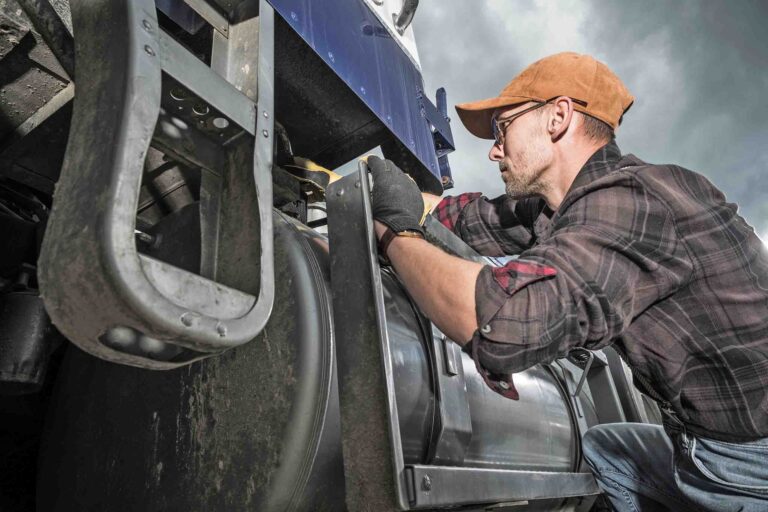AVON, Ohio — As winter gives way to spring in the next few weeks, remembering to care for your rig is more important than ever.
Bendix Tech Tips’ latest series offers reminders of springtime practices to help put winter behind.
Air Matters
A truck’s physical workings, such as the air brake system, can take a brutal beating during the cold, icy winter months. This can be especially true if the vehicle travels through temperature changes with freeze-and-thaw cycles. Coming out of winter, drivers and technicians should pay extra attention to component performance.
“Take the air system, for example,” said Jason Kolecki, Bendix director of marketing and customer solutions, Air Supply and Drivetrain. “As more trucking systems depend on a reliable supply of clean and dry compressed air – including Automated Manual Transmissions (AMTs), emissions controls, and full stability – proper maintenance of the air system after winter is key to keeping vehicles on the road and in good operating condition.”
What to look for? Air dryers mounted on the frame rail are susceptible to corrosion because of their exposure to the road – this scenario is particularly true of the seats around the purge and pressure protection valves, as well as the governor connection. Water can mix with dirt, sand, and road chemicals and form residue that can clog purge and pressure protection valves and other air dryer parts – preventing their proper operation. In addition, steel air tanks can also corrode and develop small punctures.
During inspections, keep an eye out for cracking or breakage of plastic air-line tubing that connects the dryer to the truck’s air system. Chemicals and temperature cycling can also affect push-to-connect air fittings.
According to Kolecki, air leaks may be present even if they’re unseen or unheard.
“A good indication that your system may be losing air is if charging the tanks takes significantly longer – three or four minutes, for example, as opposed to one or two,” he said. “The same is true if the system is charging more often. Increased charging cycles means more air going through the dryer, which affects the life of the dryer cartridge.”
Bendix recommends the air dryer cartridge be serviced yearly. If the air dryer cartridge wasn’t switched out in the fall, then spring is a good time to replace it. Remember to replace oil-coalescing cartridges like-for-like.
Brake Care
“When it comes to brakes, after winter, you are looking for corrosion, damage, and missing or loose components – not unlike any standard inspection,” said Mark Holley, Bendix director of marketing and customer solutions, Wheel-End.
Examine brake friction for good condition – no lining cracks, missing portions, or oil or grease contamination – and minimum thickness. If it’s time for new friction, be sure to stay up to spec: Not all friction that is marketed as “acceptable” under current Reduced Stopping Distance (RSD) regulations will actually perform to that standard. Select components that will ensure the original equipment manufacturer requirements are met so the vehicle remains compliant. If the friction needs to be replaced, it must be replaced on both sides of the axle.
“For brake chambers, make sure the dust plugs are seated properly to prevent corrosive materials from getting inside and causing internal damage,” Holley said. “Technicians should also measure chamber stroke at each wheel-end to ensure proper brake adjustment. In addition, examine the air lines – you want to see that everything is tied up properly and that there is no chafing. Check for damage in the mounting mechanism as well.”
On vehicles with air disc brakes, examine the rotor for corrosion and to be sure the cooling fins are not plugged up, which would prevent the rotor from cooling properly. Inspect the chamber for damage or corrosion. Also look at the air hoses and clamping mechanism to ensure they’re intact.
“We advise technicians to inspect the boots for punctures or tears too, as any opening into the caliper can lead to corrosion,” Holley said. “And check the integrity of the guide pins. Replace parts where necessary, and make sure the shear adapter cover is in place and fully seated. The pads should move freely in the carrier, so you should remove them and clean the carrier surface with a wire brush, if necessary. Also check to ensure that the brake moves freely on its guidance system.”
Holley continued, “For brakes overall, the importance of lubrication can’t be overstated: It keeps moisture from building up and enabling corrosion. Coming out of winter, newly grease all your automatic slack adjusters, clevis pin connections, cam tubes, shafts, and bushings.”
Ensure Optimized Valve Performance
The feel of the brakes is also important; sometimes, it may feel as if they’re responding more “slowly” to the driver’s push of the brake pedal. This feeling may indicate valve seals in the system that have had their lubricant degraded through corrosion – or possibly by the use of de-icing solutions if the air system froze during the winter.
“We recommend not adding brake anti-freeze compounds to the air system but understand that sometimes it’s unavoidable for getting trucks back on the road quickly and safely,” Holley said.
If you’ve had to use a de-icing solution, then spring is a good time to check for leaks around brake valves where O-rings might have been exposed to the chemicals. Now is also a good time to replace valves that may be sticking internally because of loss of lubrication. Some fleets routinely change out air valves as part of post-winter preventive maintenance.
Advanced Driver Assistance Technologies
Technologies like antilock braking systems (ABS) and electronic stability control — which are the foundation of advanced driver assistance systems (ADAS) — are not immune to rough winter conditions.
“One ABS concern centers on wheel-speed sensors, which can be susceptible to chassis harness issues,” said TJ Thomas, Bendix director of marketing and customer solutions, Controls. “Wire harnesses can get damaged by chafing, gravel, or corrosion. Any wiring on the chassis can be at risk because once a damaged wiring harness gets wet, it is more likely to short out. A common source of calls to the Bendix tech support team this time of year is post-winter electrical shorts and the brake system component malfunctions that result.”
Frayed or cut chassis wires can also cause potential issues with the ADAS camera or radar. Bendix advises checking the chassis harness and connectors near the ADAS camera or radar should a problem with the system be detected or if the system doesn’t seem to be working optimally.
“An issue that may arise for stability control can be the steering angle sensor out of calibration, which can sometimes happen after a front-end alignment,” Thomas said. “It’s important to calibrate the steering angle sensor after almost any work is done on the front-end.”
Radar units face their own challenges. Since the radar is on the front of the vehicle, the connector can be exposed to all sorts of chemicals – which is especially true in winter when salt and other substances are used on roads. It’s a good practice to make sure the connector is properly covered, sealed, and secured, which will help minimize the corrosion that may occur from repeated exposure to moisture and road chemicals.
Tires help ensure that ADAS technologies work at their best. Drivers can double-check their wheel-ends for adequate tire tread depth and unusual wear like cracking. In the shop, technicians should make sure tire pressure monitoring systems are operating properly after the temperature swings of winter — running on the right inflation is critical.
Born in Pine Bluff, Arkansas, and raised in East Texas, John Worthen returned to his home state to attend college in 1998 and decided to make his life in The Natural State. Worthen is a 20-year veteran of the journalism industry and has covered just about every topic there is. He has a passion for writing and telling stories. He has worked as a beat reporter and bureau chief for a statewide newspaper and as managing editor of a regional newspaper in Arkansas. Additionally, Worthen has been a prolific freelance journalist for two decades, and has been published in several travel magazines and on travel websites.
















Bendix? Ain’t this the company that also makes wind-up wristwatches?
Wish they’d fix My🤔watch from them: battery is all rusted-up & the hands no longer move.
0ther than That it still looks good And… in all fairness… it still gives correct time Twice A Day.👻